#UMMCGrad19: SGSHS student says 'yes' to selfless excellence
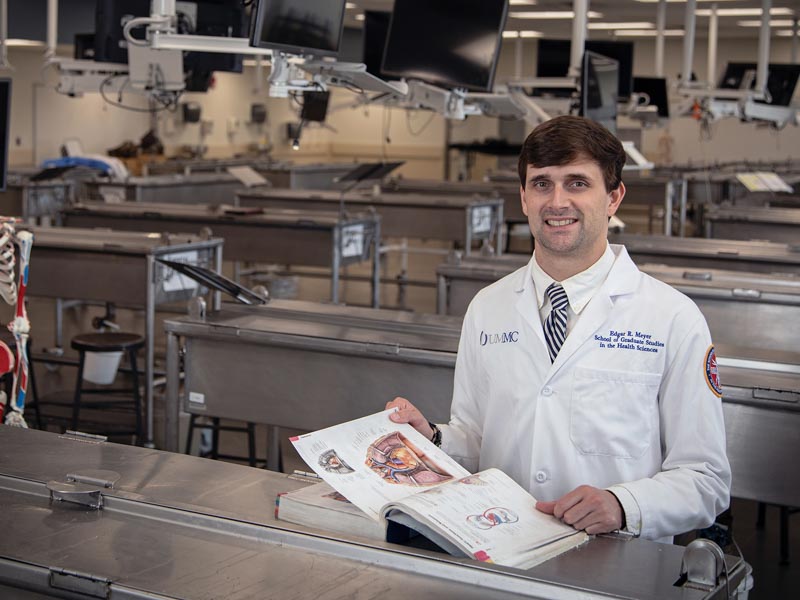
On any given day, you can find Edgar Meyer darting around the University of Mississippi Medical Center, being on opposite ends of the campus in the same day as he goes from Associated Student Body roundtables, alumni events, interfaith dialogues and the anatomy labs on the seventh floor of the old hospital.
How does one student end up serving on no fewer than 20 campus committees while writing a dissertation and handling teaching assistantship duties?
"I'm a bit of a 'yes man,'" said Meyer, who is graduating with a Ph.D. in clinical anatomy from the School of Graduate Studies in the Health Sciences.
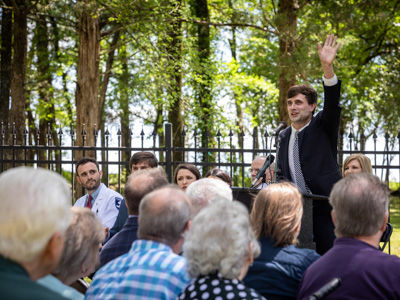
But it's more than that: a selfless sense of service, a commitment to faith and a willingness to engage all around him. Saying "yes" has opened a lot of doors.
Meyer, who grew up on a farm in Bolivar County, was always interested in science and has an uncle who graduated from the School of Medicine.
After studying pre-med and classics at Millsaps College, Meyer applied to the School of Medicine but got a "no" in response. With the encouragement of a professor, he took a job teaching Latin at St. Joseph Catholic School in Madison, a move that changed his career path.
"I realized I loved teaching so much, I went on to get an education degree," Meyer said, who earned a master's degree in teaching at Delta State University. He then taught biology, anatomy and physiology, and chemistry for a couple years at Ray Brooks School in Benoit, which set the stage for his entry into anatomy.
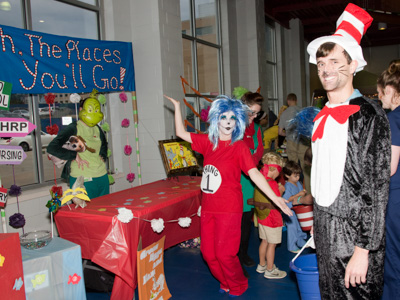
Clinical anatomy stands out among the other Medical Center-based Ph.D. programs due to its focus on educational research. The students study the process of learning through the context of anatomy, arguably the most conserved area of health science professional training.
"I loved anatomy and teaching, and here was this program that blended the two," Meyer said.
While working on a literature review during his anatomy rotations, he came upon one of those factoids about the brain that makes you think.
"We typically forget 70 (percent) to 80 percent of what we learn within 30 days," Meyer said, citing studies on memory by Hermann Ebbinghaus. "So I started to think about a project for measuring and improving long-term retention, which is critical in anatomy."
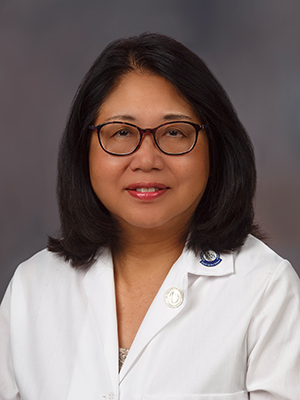
Cui
Dr. Dongmei Cui, associate professor of neurobiology and anatomical sciences, said "yes" to Meyer's dissertation idea and helped him develop a project to assess how virtual three-dimensional models of the middle and inner ear can help medical students learn their anatomy.
Beyond his research and teaching duties, Meyer became a presence on campus. Enough students voted "yes" to make him president of the Associated Student Body for 2018-19. During his tenure, he set several goals to encourage service learning, interprofessional education, and diversity and inclusion initiatives in partnership with other campus offices.
"We also started hosting roundtable discussions where students could share their concerns or ideas for how to improve their experience, like increasing study spaces," Meyer said.
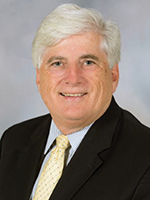
"Edgar has this 'can-do' enthusiasm and ability to connect with people that make him a valuable member of the graduate school, and he has done quite well here," said Dr. Joey Granger, dean of the SGSHS.
Granger had a running joke where each time he passes Meyer in the hall he asks, "How's that dissertation coming?" a nod to his busy schedule and looming deadline.
Meyer successfully defended in February, enough so that the SGSHS granted Meyer the 2019 Robert A. Mahaffey Jr. Award, which recognizes exceptional potential in a graduating student. The nomination letter speaks of his ability to communicate clearly with multiple groups of people and his sense of engagement on- and off-campus.
"You can never underestimate the importance of a relationship," Meyer said. "There are so many opportunities that start as an idea, and then through an email or a conversation, a connection forms and it morphs into something achievable."
One of the most important aspects of Meyer's life is his faith, shaped by his time teaching in a Catholic school and his training in an interprofessional health environment. He sees mind, body and soul all as important parts of helping people become well, especially in a region as steeped in religious tradition as the Bible Belt.
Meyer co-founded UMMC's Catholic Students Association and Faith Forum, a dialogue and lecture series that hosts speakers that represent several faith and spiritual perspectives. Head chaplain Doris Whitaker said "yes" to helping Meyer form a student chaplain program last fall, where UMMC students can learn how to meet with and support people of any or no faith tradition in their time of need.
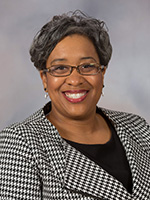
"He adds value wherever he goes, creating conversations, activities and developing educational opportunities that will generate understanding and connection rather than misunderstandings and separation," Whitaker said. "Edgar has the capacity and inclination to 'dig' into the community in which he finds himself and works to make that community richer, stronger and better."
"How often do we say no to things that may help form who we are as a health science professional and as a human?" Meyer said. "The one problem with people saying they are too busy is that they miss these opportunities."
Meyer is on the job hunt, applying for junior faculty positions in anatomy departments of medical schools, primarily in the Southeast. Of all the courses that anatomists can potentially teach, the one he's most interested in is histology, which he first fell in love with as an undergraduate at Millsaps.
"When you look under the microscope, there's this kaleidoscope of color," Meyer said. "Looking at cells or tissues and their components can tell you exactly what organ it came from, the function it has. And from a pathological perspective, you can diagnose disease from these slices of tissues."
Hopefully, one of those institutions will say "yes" to an anatomist from Mississippi.


